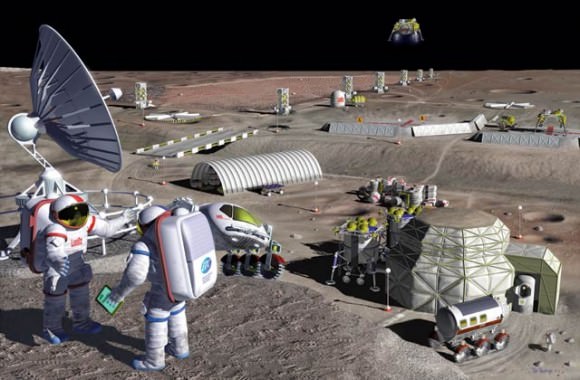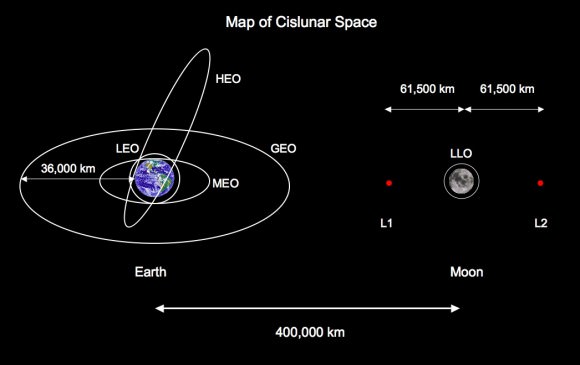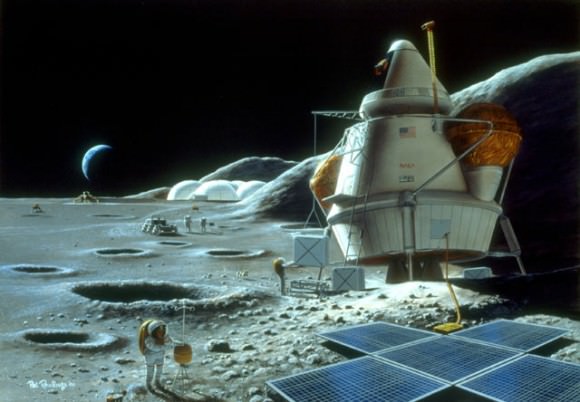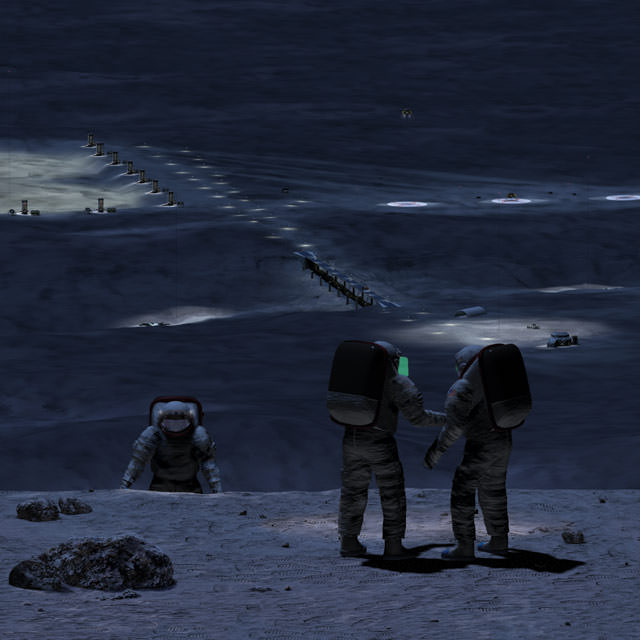[/caption]
It’s long been a dream to have a human settlement on the Moon, but in this age of budget cuts and indecisive plans for NASA’s future, a Moon base may seem too costly and beyond our reach. However, noted lunar scientist Dr. Paul Spudis from the Lunar and Planetary Institute and a colleague, Tony Lavoie from the Marshall Space Flight Center, have come up with a plan for building a lunar settlement that is not only affordable but sustainable. It creates a Moon base along with a type of ‘transcontinental railroad’ in space which opens up cislunar space – the area between Earth and the Moon – for development.
“The ultimate goal in space is to be able to go anywhere, anytime with as much capability as we need,” Spudis told Universe Today. “This plan uses a robotic and human presence on the Moon to use the local resources to create a new spacefaring system. The key for doing this is to adopt a flexible approach that is incremental and cumulative.”
In a nutshell what Spudis proposes is to send robots to the Moon which are tele-operated from Earth to start extracting water from the polar deposits to create propellant. The propellant would be used to fuel a reusable space transportation system between the Earth and the Moon.
“The reason this is possible is because the Moon is close – it’s only three light-seconds round trip for radio signal get from Earth to the Moon back,” Spudis said, “which means you can control machines remotely with operators on the Earth actually doing the activities that an astronaut might do on the Moon.”

The advantage here is that a large part of the needed infrastructure, such as the mining operation, the processing plants, the development of storage for the water and propellant, is created before people even arrive.
“So what we try to do is to develop an architecture that enables us to, first, do this in small, incremental steps, with each step building upon the next, and the net effect is cumulative over time,”Spudis said. “And finally we are able to bring people to the Moon when we’re ready to actually have them live there. We place an outpost — a habitat — that will be fully operational before the first humans arrive.”
The significant amount of water than has been found on the Moon at the poles makes this plan work.
“We estimate there are many tens of billions of tons of water at both poles,” Spudis said. “What we don’t know in detail is exactly how much water is distributed what physical state it is in, and that’s one of the reasons why the first step in our plan is to send robotic prospectors up there to map the deposits and see how they vary.”
Water is an important resource for humans in space: it supports life for drinking and cooking, it can be broken down into oxygen for breathing, and by combing the oxygen and hydrogen in a fuel cell, electricity can be generated. Water is also a very good shielding material that could protect people from cosmic radiation, so the habitat could be “jacketed” with water.
But the most important use of water is being able to create a powerful chemical rocket propellant by using the oxygen and hydrogen and freezing them into a liquid.
“The Moon offers us this water not only to support human life there, but also to make rocket propellant to allow us to refuel our spacecraft both on the Moon and space above the Moon.”
In a series of 17 incremental missions, a human base would be built, made operational and occupied. It starts with setting up communication and navigation satellites around the Moon to enable precision operation for the robotic systems.
Next would sending rover to the Moon, perhaps a variant of the MER rovers that are currently exploring Mars, to prospect the best places for water at the lunar poles. The poles also provide areas of permanent sunlight to generate electrical power.
Next, larger equipment would be sent to experiment with digging up the ice deposits, melting the ice and storing the products. (See our previous article about using bulldozers on the Moon).
“Now, all those are simple conceptually, but we’ve never done them in practice,” said Spudis, “so we don’t know how difficult it is. But by sending the small robotic missions to the Moon and practicing this via remote control from Earth, we can evaluate how difficult it is — where the chokepoints are — and what are the most efficient ways to get to these deposits and to extract usable a product from them.”
The next step is to increase the magnitude of the effort by landing bigger robotic machines that can actually start making product on industrial scales so that a depot of supplies can be stockpiled on the Moon for when the first human humans to return to the Moon.

In the meantime, a constant transportation system between Earth and Moon would be created, with another system that goes between the Moon and lunar orbit, which opens up all kinds of possibilities.
“The analogy I like to make is this is very similar to the Transcontinental Railroad,” Spudis said. “We didn’t just build the Transcontinental Railroad to from the East Coast directly to the West Coast; we also built it to access all the points in between, which consequently were developed economically as well.”
By having a system where the vehicles are refueled from the resources extracted on the Moon, a system is created that routinely accesses the Moon and allows for returning to Earth, but all the other points in between can be accessed as well.
“We create a transportation system that accesses all those points between Earth and Moon. The significance of that is, much of our satellite assets reside there,” said Spudis, “ for example communication satellites and weather monitoring satellites reside in geosynchronous orbit, (about 36,000 km above the Earth’s equator) and right now we cannot reach that from low Earth orbit. If we have system that can routinely go back and forth to the Moon, we could also go to these high orbits where a lot of commercial and national security assets are.”
Spudis added that a fuel depot could go in various locations, including the L1 LaGrange point which would enable space flight beyond the Moon.
How long will this take?
“We estimate that we can create an entire turn-key lunar outpost on the Moon within about 15 to 16 years, with humans arriving about 10 years after the initial robotic missions go,” Spudis said. “The mining operation would produce about 150 tons of water per year and roughly 100 tons of propellant.
And do any new technologies or hardware have to be built?
“Not really,” said Spudis. “Effectively this plan is possible to achieve right now with existing technology. We don’t have any ‘unobtainium’ or any special magical machine that has to be built. It is all very simple outgrowths of existing equipment, and many cases you can use the heritage equipment from previous missions.”
And what about the cost?
Spudis estimates that the entire system could be established for an aggregate cost of less than $88 billion, which would be about $5 billion a year, with peak funding of $6.65 billion starting in Year 11. This total cost includes development of a Shuttle-derived 70 mT launch vehicle, two versions of a Crew Exploration Vehicles (LEO and translunar), a reusable lander, cislunar propellant depots and all robotic surface assets, as well as all of the operational costs of mission support for this architecture.
“The best part is that because we have broken our architecture into small chunks, each mission is largely self-contained and once it gets to the Moon it interacts and works with the pieces that are already there,” Spudis said.
And the budget would be flexible.
“We can do this project at whatever speed the resources permit,” Spudis said. “So if you have a very constrained budget with very low levels of expenditure, you can go you just go much more slowly. If you have more resources available you can increase the speed and increase the rate of asset emplacement on the Moon and do more in a shorter period of time. This architecture gets us back to the Moon and creates real capability. But the free variable is schedule, not money.”

Returning to the Moon is important, Spudis believes, because not only can we use the resources there, but it teaches us how to be a spacefaring civilization.
“By going to the Moon we can learn how to extract what we need in space from what we find in space,” he said. “Fundamentally that is a skill that any spacefaring civilization has to master. If you can learn to do that, you’ve got a skill that will allow you to go to Mars and beyond.”
For more information see Spudis’ website, SpudisLunarResources.com More details and graphs can be found on this pdf document.
Listen to an interview of Paul Spudis on this topic for the 365 Days of Astronomy podcast.
Paul Spudis blogs at Once and Future Moon at Smithonsian Air & Space website.


I think one problem is that we don’t have a lot of experience operating machinery on the moon. The Mars rovers have provided experience operating on the martian surface, but the lunar environment is different. I would think that the first step would be sending rovers to the moon to understand the problem of operating machinery in that environment over a long period of time.
That is why we send robots out there to the Moon.
To get the needed experiences.
I am all for robotic explorations of the Moon.And first on my wish list as a live robotic webcam I can see from my computer.
Russian lunokhods on the Moon 40+ years ago was real time operator (pilot) driven. From the Earth.
Going to the Moon is not so much about technology. With current technology we could go to the Mars. All we need is long term political will to go there. And that’s what we completely lack.
We had a buggy on the moon! I think that counts as experience.
Here’s a thought: Convince Mark Zuckerberg to finance the whole thing. Promise to name the first Lunar city after him if he does. Get face book followers to back the mission and Zuckerberg probably comes out money ahead. Taxpayers win, no tax dollars spent. Humanity wins, we get off this rock. Nancy, why don’t you give him a call?
One teensy weensy little problem here: The Moon Treaty and the OST (Make that two problems!)
Oh I forgot America owns the Moon. Doesn’t it?
UNCLOS
http://en.wikipedia.org/wiki/United_Nations_Convention_on_the_Law_of_the_Sea#Signature_and_ratification
Um, what? Why do you point to aerial observation (OST) and ocean exploitation (UNCLOS) treaties respectively laws?
The Moon Treaty is modeled on the Antarctic Treaty. Do you see an absence of Antarctic bases, national to wit?
Um, what? Why do you point to aerial observation (OST) and ocean exploitation (UNCLOS) treaties respectively laws?
The Moon Treaty is modeled on the Antarctic Treaty. Do you see an absence of Antarctic bases, national to wit?
I love this idea. The difficulty I have been wrestling with personally is finding a way to sell it to the tax payers. This plan is quite sound but it looks like it would be 15 years before there would be hope of ROI, this makes finding private funding difficult so we are left with government projects. How do we convince the populace this is a good idea? One tactic I have been trying out on an individual basis is piggybacking on the environmentalists limits to growth theory, fear of starvation and a destitute world economy is a great motivator but not great enough. Are there any other ideas out there?
I like.. and have posted similar. Sign me up! How about.. lets get a petition going to send to P. Obama?
I think we need a future to look forward to instead of constantly rehashing the past. I think we need to generate NEW industries and ‘gently’ retire the old ones. As much as I despise the oil industry – they DO run the whirled.. at least for the time being. The ONLY way we will accomplish these goals so to show ‘them’ how ‘they’ can make money doing it! In other words, we have to take the ‘greedy’ along for the ride.. or we aren’t going to get there. ‘We’ being.. the 99%! Maybe later we can change the ‘odds’ a bit?
My point may best be demonstrated by this ‘joke’?
His name was Bubba, he was from Mississippi ….. and he needed a loan, so…….
he walked into a bank in New York City and asked for the loan officer. He told the loan officer that he was going to Paris for an international Redneck festival for two weeks and needed to borrow $5,000 and that he was not a depositor of the bank.
The bank officer told him that the bank would need some form of security for the loan, so the Redneck handed over the keys to a new Ferrari. The car was parked on the street in front of the bank. The Redneck produced the title and everything checked out. The loan officer agreed to hold the car as collateral for the loan and apologized for having to charge 12% interest.
Later, the bank’s president and its officers all enjoyed a good laugh at the Redneck from the south for using a $250,000 Ferrari as collateral for a $5,000 loan. An employee of the bank then drove the Ferrari into the bank’s private underground garage and parked it.
Two weeks later, the Redneck returned, repaid the $5,000 and the interest of $23.07. The loan officer said, “Sir, we are very happy to have had your business, and this transaction has worked out very nicely, but we are a little puzzled. While you were away, we checked you out on Dunn & Bradstreet and found that you are a Distinguished Alumni from Ole Miss University, a highly sophisticated investor and Multi-Millionaire with real estate and financial interests all over the world. Your investments include a large number of wind turbines around Sweetwater, Texas. What puzzles us is, why would you bother to borrow $5,000?”
The good ‘ole boy replied, “Where else in New York City can I park my car for two weeks for only $23.07 and expect it to be there when I return?”
Once again humanity is being handcuffed by this outdated monetary system man has constructed. If we lived in a Resource Based Economy advocated by The Venus Project, based on the technology we have today we would already have bases on the Moon and Mars. Humanity is so dumb and stupid at the same time.
Collectively humanity seems dumb, but individually we are very intelligent. It’s just the ol’ tragedy of the commons playing itself out on so many arenas, so many scales.
As nice as the venus project is, human nature (for which we are not at fault – it’s in our genes) will always be a barrier.
“A person” is smart; “People” are dumb, panicky, dangerous animals, as a wise man once said. Plus, they seem to absolutely love counting their money, like that little monkey pressing the lever for more cocaine. Good luck with that.
I appriciate your opinion on the subject of human nature, but that is all it is, an opinion. Humans have been conditioned over the years to believe and act in a certain way depending what environment they come from. The video presentaions I’ve included are less than 3 minutes in lenght by experts in the subject of human nature. Paste or click these links to your browser for more info.
http://www.youtube.com/watch?v=rlF3eoQ_lLw&feature=related
if only we could pool the contributions of the wealthy for an interplanetary space society, we would be well on the way… The problems are 1. our nation based system 2. our outdated global economic system and 3. purely interest based approach, i.e. through lobby-ism (which is nothing but corrupt).
I think the basic idea is essentially sound.
As a context, Musk notes that mining of the system would always be more expensive than doing it on Earth (or find local replaceables). But that misses the problem of supplying affordable volatiles to NEO tourism and exploration.
Of course, nothing like the funding mentioned will be spent to exploit this anytime soon.
But … why!?
Those assets are much more affordable replaced by sending up new and modernized probes every time. Even Kepler would ultimately have been less costly to replace that way than to do recurring service & upgrade.
Cheaper volatiles won’t mean that much to the cost picture of two way trips compared to one way trips.
With an unreliable agency whose plans change every 4 years with a new white house administration, tax-payer dollars are just going to go down a bureaucratic black hole.
These endeavors need to be carried out by the private industry who are mainly motivated by profit and glory of opening up the frontier of space. Privatized ventures are more focused, streamlined and are not subject to the constant money-wasting haggling that NASA seems to be suffering from lately.
I see NASA playing a big role in this however. They can establish the much needed communications network required for any large-scale endeavor, a lunar positioning system much like the GPS. They can perform much needed technological demonstrations for a number of issues: dust management, radiation management, low-gravity fluid transfer.
What NASA gives to the industry in support, the industry can give back to NASA in terms of materials mined. Oxygen, silicon, aluminum etc.
years of freaking huge budget with minimal improvement.
since the budget cut, now we are talking about moon base, first human to mars and etc.
good job NASA